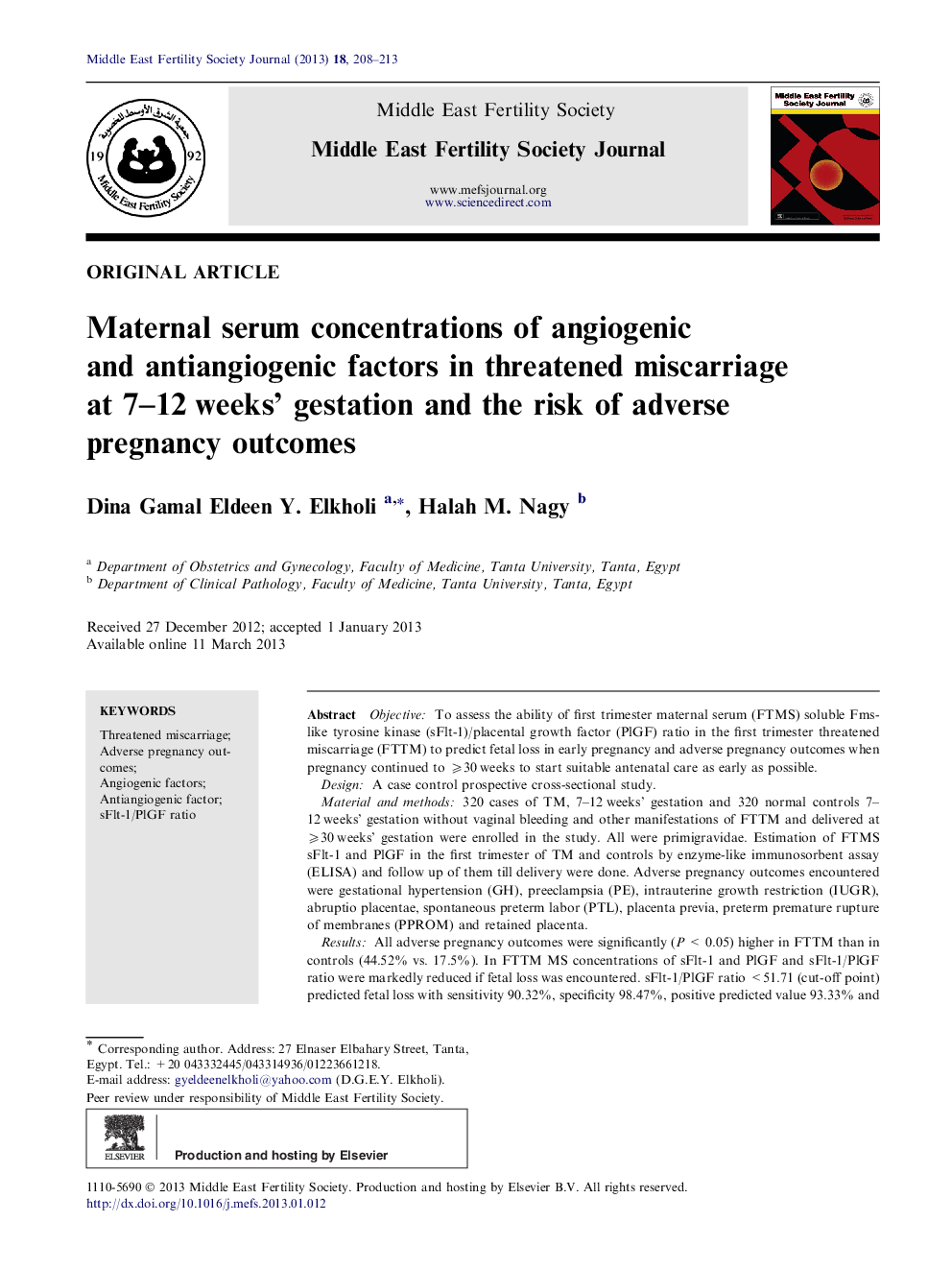| Article ID | Journal | Published Year | Pages | File Type |
|---|---|---|---|---|
| 3966294 | Middle East Fertility Society Journal | 2013 | 6 Pages |
ObjectiveTo assess the ability of first trimester maternal serum (FTMS) soluble Fms-like tyrosine kinase (sFlt-1)/placental growth factor (PlGF) ratio in the first trimester threatened miscarriage (FTTM) to predict fetal loss in early pregnancy and adverse pregnancy outcomes when pregnancy continued to ⩾30 weeks to start suitable antenatal care as early as possible.DesignA case control prospective cross-sectional study.Material and methods320 cases of TM, 7–12 weeks’ gestation and 320 normal controls 7–12 weeks’ gestation without vaginal bleeding and other manifestations of FTTM and delivered at ⩾30 weeks’ gestation were enrolled in the study. All were primigravidae. Estimation of FTMS sFlt-1 and PlGF in the first trimester of TM and controls by enzyme-like immunosorbent assay (ELISA) and follow up of them till delivery were done. Adverse pregnancy outcomes encountered were gestational hypertension (GH), preeclampsia (PE), intrauterine growth restriction (IUGR), abruptio placentae, spontaneous preterm labor (PTL), placenta previa, preterm premature rupture of membranes (PPROM) and retained placenta.ResultsAll adverse pregnancy outcomes were significantly (P < 0.05) higher in FTTM than in controls (44.52% vs. 17.5%). In FTTM MS concentrations of sFlt-1 and PlGF and sFlt-1/PlGF ratio were markedly reduced if fetal loss was encountered. sFlt-1/PlGF ratio <51.71 (cut-off point) predicted fetal loss with sensitivity 90.32%, specificity 98.47%, positive predicted value 93.33% and negative predictive value 97.60%. Patients that developed adverse pregnancy outcomes related to impaired placentation as GH, PE, IUGR, PTL <34 weeks’ gestation and abruptio placentae had reduced FTMS PlGF and increased sFlt-1/PlGF ratio, in both FTTM and controls. Soluble Flt-1/PlGF ratio >74.6 (cut-off point) predicted these adverse pregnancy outcomes with sensitivity 88.70%, specificity 95.40, positive predictive value 90.16% and negative predictive value 94.68% – adverse pregnancy outcomes not related to placental impairment as PLT >34 weeks’ gestation, PPROM, placenta previa and retained placenta were not predicted by sFlt-1/PlGF ratio because in these conditions FTMS concentration of these factors were normal.Conclusions1-Adverse outcomes late in pregnancy (⩾30 weeks’ gestation) were more common in FTTM. 2-Diminished FTMS concentration of sFlt-1 and PlGF as well as sFlt-1/PlGF ratio <51.71 may predict fetal loss in FTTM. 3-In FTTM and normal controls FTMS PlGF was reduced and sFlt-1/PlGF ratio >74.6 may predict development of adverse outcomes characterized by impaired placentation. 4-Adverse pregnancy outcomes not related to impaired placentation were associated with normal FTMS concentration of sFlt-1 and PlGF and were not predicted by sFlt-1/PlGF ratio.
